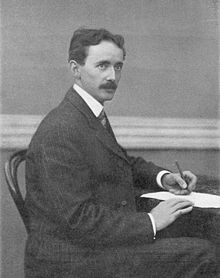Moore tube
| Daniel McFarlan Moore | |
|---|---|

1906 photograph taken by the light of a Moore lamp
|
|
| Born |
February 27, 1869 Northumberland, Pennsylvania |
| Died | June 15, 1936 (aged 67) East Orange, New Jersey |
| Cause of death | Murder |
| Occupation | Engineer |
| Spouse(s) | Mary Alice Elliott (m. 1895) |
| Parent(s) | Alexander Davis Moore Maria Louisa Douglas Moore |
Daniel McFarlan Moore (February 27, 1869 – June 15, 1936) was a U.S. electrical engineer and inventor. He developed a novel light source, the "Moore lamp", and a business that produced them in the early 1900s. The Moore lamp was the first commercially viable light-source based on gas discharges instead of incandescence; it was the predecessor to contemporary neon lighting and fluorescent lighting. In his later career Moore developed a miniature neon lamp that was extensively used in electronic displays, as well as vacuum tubes that were used in early television systems.
He was born in Northumberland, Pennsylvania on February 27, 1869. Moore was the son of the Reverend Alexander Davis and Maria Louisa Douglas Moore. He graduated from Lehigh University in 1889. Moore married Mary Alice Elliott, of New York City, on June 5, 1895. They had three children: Dorothy Mae Moore, (born 1900); Elliott McFarlan Moore (1902–1933); and Beatrice Jean Moore, (born 1912).
He began his career in 1890 working in the engineering department of the United Edison Manufacturing Company. At some point he started experimenting with producing light from glow discharges, which Heinrich Geissler had first developed in the 1850s. "What’s wrong with my light?" Thomas Edison is said to have asked when he learned that Moore had started to tinker with light-producing tubes of gas as a potential replacement for the incandescent bulb. Moore is reported to have replied undiplomatically, "It’s too small, too hot and too red." Moore left in 1894 to form his own companies, the Moore Electric Company and the Moore Light Company.
Moore had devised his glow discharge lighting system by 1896. The Moore Lamp was an extension of the well-known Geissler tube, which used glass tubes from which the air had been removed and a different gas inserted. The low-pressure gas glows when a current is passed through it. As described in 1915, "In the Moore system of lighting the essential feature is the introduction of a special valve which automatically admits gas into the tube as the supply becomes exhausted." The Moore lamps utilized nitrogen or carbon dioxide as the luminous gas; Moore's innovation compensated for the gradual loss of gas in the lamp to the electrodes and the glass. Carbon dioxide gave a good quality white light. The first commercial installation was done in 1904 in a hardware store in Newark, New Jersey. The lamp yielded about 10 lumens per watt, which was about triple the output of incandescent lights based on carbon filaments. Arthur Bright has written, "Despite the fact that the tube was expensive to install, complicated, and required very high voltages, its operating advantages were great enough for it to find restricted use in stores, offices, and similar general lighting uses as well as in photography and some advertising and decorative applications."
...
Wikipedia
